#ganharomundo
Explore tagged Tumblr posts
Text
Smart Cities and the potential Misuse of Data
Context
During the seven weeks of the Pre-College Summer Intensive English Program at The New School, my class was divided into groups of three to work on a Capstone project. Each group received a broad theme, and our job was to narrow it down to build a presentation with a specific thesis, which was presented to an audience composed by The New School Faculty and Staff on August 3rd. We also had to write separate research papers with paraphrased academic sources.
My team got Technology as a topic. The following text consists on the final research paper I handed in, named Smart Cities and the Potential Misuse of Data.
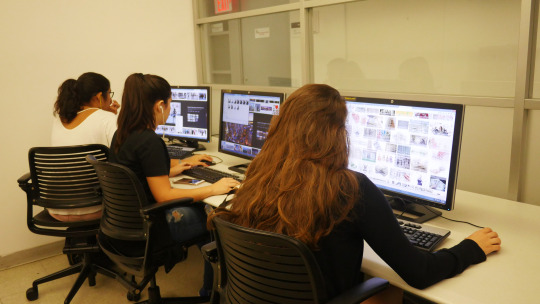
Credits: Gabriella Ullauri
Introduction
Smart Cities are emerging hotspots. Huge producers of Data, these are places that aim to use the personal information collected from its citizens to improve public infrastructure. Cities like Singapore, London, and New York are among the few that openly declare their attempt to adapt to this new model. In the case of NYC, this undertake exists since the year 2000: presented on September 28th of that year, at the 2nd International Life Extension Technology Workshop in Paris, the document entitled “The Vision of A Smart City” stated the early solid efforts of the city government (in consonance to Brookhaven National Laboratory) to integrate the city. According to this report, the main strategies at that point included underground utility mapping and passive structural integrity monitoring.
As written in the article "Addressing big data challenges in smart cities: a systematic literature review", the gathering and use of Big Data through new technologies increases information awareness, facilitating the policy-making process while creating many alternatives for social interaction in the city. In that sense, the data compiled enhance real-time services automation, which consequently drives city administration towards making urban management more effective. Examples of that would vary from installing intelligent traffic lights to monitoring the conditions of infrastructure in public areas, transforming urban settings into more dynamic spaces. And that is what should happen in smart cities.
But although the authors’ conclusions are true and can be extremely beneficial to society, there is an aspect that is often overlooked: A Smart City is a direct product of its government. Despite the idea and the tools to implement it, what is done to the online content is not a matter of technicality. Once carrying people’s information, the success of a Smart City is an outcome of political intention. And that can be disastrous.

Songdo, a smart city in construction since 2004. Retrieved from https://youngining.wordpress.com/2015/08/08/smart-city-songdo-incheon-korea/
We know humanity is now experiencing an invisible revolution. At the beginning of the XXI Century, there were already 502 million internet users in the world [1]. In 2012, 67% of the internet users had social media accounts [2]. In 2013, 56% of American adults owned a smartphone [3]. What these numbers show is a fast transition to the globalized world. But the intrinsic fact is that the latest changes are not material, yet virtual. They consist on the interpretation of our personal lives, sprinkled in infinite bytes of Data.
In this scenario, Big Data is a key term, once it can be stated as the theoretic column of smart cities. Amply used in the sense of an amount of complex, coded information., it has intrigued tech enthusiasts for different reasons: The interpretation of this informational web has many uses, from knowing a target audience for a product to extracting index statistics. But while some agree that it can be a tool to address the Common Good, others argue that once addressing particular interests, it can be a weapon for controlling of the public opinion.
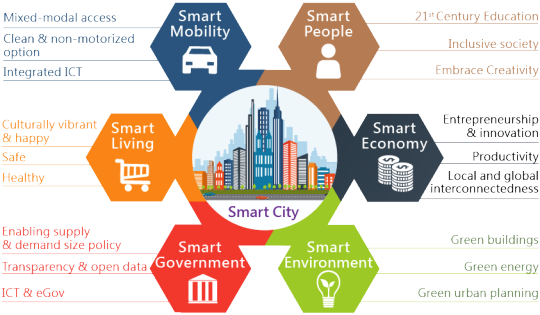
Retrieved from https://smartcity.org.hk/index.php/aboutus/background
This way, the conception of privacy and State’s power in smart cities rises as two big question marks in our future. As we go deeper in the Digital Age and the interconnection between different devices becomes clearer, the ethical aspect of technology must be discussed. Between the absence of concrete policies to regulate enterprises and the political apathy of the civil society, privacy becomes more and more of an abstract idea: In the realm of social media, is anything really private?
To answer this question, our research tries to look into the way the governments operate in smart cities. More specifically, our approach to the privacy issue focuses on how Smart cities raise privacy concerns, considering the potential misuse of Data and violation of people’s basic civil rights. For that purpose, we adopted examples of various smart cities initiatives, from those in Boston and New York City to in Rio de Janeiro.
2. Structural vulnerabilities in Smart Cities and how they afflict its inhabitants
As humans, we often don’t want to share something. Where we are going, our health records, our bank account information: These are some examples of what it’s usually considered private matters.Yet, we display so much information online without hesitating. And by doing that, we allow private companies and governmental organizations to take advantage of it by selling or incorporating (in their databases) our personal data. Still, we trust and agree to website's security policies.
In this vicious cycle, Smart cities can be extremely vulnerable places. In their article “Data Security in Smart Cities: Challenges and Solutions”, Daniela Popescul and Laura Diana Radu write about how this happens. According to the two researchers, if on one hand the use of smart objects - that is “objects connected in order to provide seamless communication and contextual services”- enables the collection, transmission, and processing of huge amounts of Data; on the other hand, it needs to be constantly protected. These devices have multiple resource-constraints, such as network requirements, hardware limitations or software restrictions, which is an obstacle to the installation of security mechanisms. Due to these difficulties, software designers often overlook the issue of device security and prioritize other aspects of the product, such as performance and energy consumption. That seems like a way to deceive the consumer: The best-ranked tech products on the market cannot guarantee your safeness in the virtual world, and they are sold as they could.
Another factor that weakens Smart Cities’ structure is the lack of regulations. Our Capstone group had the opportunity to interview New School’s Director of Information and online security, David Curry. When asked “how secure is our Data?”, Mr. Curry said: “ In Europe, particularly, and some would say in Latin America, [...] there are very specific laws about when you collect private Data you have to say exactly what is it used for, and you’re not allowed to use it for something you didn’t say you’re going to use it for. In the United States, that’s a little squishy. As for smart cities and that kind of thing, that is a real concern: What kind of Data is being collected by what? Who has access to it? It’s the whole notion of the Internet of Things. ”
Besides not being able to guarantee information security, the smart city system doesn’t make the city accessible to all citizens. In the November edition of Fordham Urban Law Journal, the authors Kelsey Finch and Omer Tene argue that, despite the nature of government’s intentions, services offered by smart cities often impact individuals in a discriminatory way. According to Finch and Tene, that happens because the system automatically favors those used to technological devices. For example, when looking closely at the case of the Street Bump app, which was an initiative aimed to report to Boston’s Public Works Department the location of potholes and road castings, it is possible to affirm that the younger and wealthier areas of the city benefited the most. By that we can infer that people who are less likely to carry smartphones, such as seniors, were indirectly excluded from the perks of such in the same manner others did.
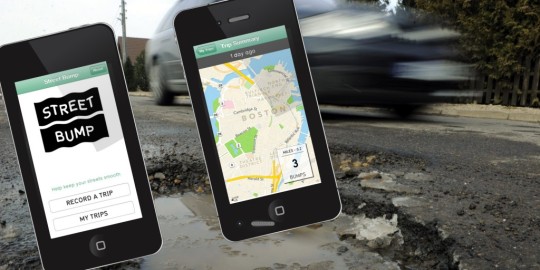
Retrieved from https://www.bu.edu/systems/2014/12/18/boston-is-becoming-a-smart-city-with-eng-support/
This problem appears in other social and infrastructural projects. For instance, take Singapore’s regulated Electronic Road Pricing (ERP) scheme. Once the toll booth system was installed in a single cordon area, dramatic changes in traffic happened. According to the book “Transport Economics”, within few months, the percentage of carpooling with less than four passengers dropped from 48 to 21, while the use of public transportation rose from 41 to 62 percent. Despite that, the average number of cars during rush hours also declined, but the traffic after ERP’s functional hours peaked. What these numbers show, in fact, is that those who could not afford the extra fee were indirectly prevented from accessing some parts of the city. As we can see, technology itself is not inclusive, and often perpetuate the status quo.

Retrieved from https://www.lta.gov.sg/content/ltaweb/en/roads-and-motoring/managing-traffic-and-congestion/electronic-road-pricing-erp.html
3. Governance vulnerabilities in Smart Cities and how it affects individual liberties
The complete eradication of privacy in Smart Cities by the government is also a risk to the current democratic system. By exchanging our information for security and practicality, we allow the government to not only know about us but also to profile us and even forecast our actions. In her article, " Legislating Privacy: Technology, Social Values, and Public Policy", Priscilla M. Regan, Professor at George Mason University, writes about the implications of new technologies in Public Policy. According to Regan, while the use of digital media devices by enterprises is usually classified as an invasion of privacy, it usually makes the organization even more powerful over individuals. That is, the online information turns into a new source of mass control, once that by accessing it, they can know one's history, activities, and proclivities.
In this scenario, minorities are groups of special interest. Historically underrepresented in public matters and often the target of authoritarian measures, this part of the population is more exposed than any other. One key factor to explain this is society’s tendency to generalize. Although the United States of America Civil Rights Act states that “All persons shall be entitled to the full and equal enjoyment of the goods, services, facilities, and privileges, advantages, and accommodations of any place of public accommodation, as defined in this section, without discrimination or segregation on the ground of race, color, religion, or national origin”[4], ethnicity, nationality, and religion continue to result in stereotypes and hate crimes. Take terrorism as an example. After the 9/11 attacks in New York, more muslims started to be selected for security checks at airports, despite the fact that most of them were peaceful individuals. Simultaneously, less of them were accepted in the U.S. as immigrants and tourists [5]. Statistically speaking, when the numbers prove that there is a profile for people that commit certain crimes, it is almost impossible to assure that there won’t be reprisals to this particular group.
Indeed, as technology makes these kinds of web intelligence acts evident, it also broadens its scope. In that sense, one concern about the interconnection of databases is shown in the forensic use of DNA. While the use of DNA samples to identify criminals boosts the efficiency of the judicial system, it also makes us question whether this measure leads to wrongful convictions. According to the article “Building a Face, and a Case, on DNA”, some researchers doubt the accuracy of the technology used in the recreation of facial images. The argument is that such techniques could stimulate racial profiling among law enforcement agencies, consequently affecting individual privacy and resulting in a violation the Fourth Amendment, which states: “The right of the people to be secure in their persons, houses, papers, and effects, against unreasonable searches and seizures, shall not be violated, and no warrants shall issue, but upon probable cause, supported by oath or affirmation, and particularly describing the place to be searched, and the persons or things to be seized.”[6]

Retrieved from http://nuffieldbioethics.org/project/bioinformation
Another example of how good ideas can become dangerous is seen in New York City. Recently, the City Hall opened the possibility to its citizens of avoiding bureaucracy when registering to its Supplemental Nutritional Assistance Program through an app called HRA Mobile. Instead of handing documents directly to a social services office, applicants can quickly upload them using the platform. According to Nina Stewart, the reporter behind the New York Times’ headline “Those Needing Food Stamps Find City App Eases the Path”, from March to June 2017, more than a million documents were posted. What is not said in the news, however, is what else these Data can be used for. From mere statistic purposes to profiling people to make use of populist measures, there are unlimited possibilities.
Unfortunately, one of the effects of Big Data usage by the government can be the perpetuation of tyranny. When it comes to an actual vigilance mechanism, the lack of privacy that is characteristic of Smart Cities becomes a dangerous threat to freedom of thought and expression. In the article “The watchers”, the author, Jonathan Shaw, argues that the mere awareness of surveillance reshapes people's behavior. This happens because, once you know you are constantly being watched, you tend to be more careful in your actions. According to the text, many governments use this kind of self-censorship to perpetuate its values. One example of this comes from China. By basing its system in 24/7 vigilance and rigorous repression, the Chinese government manages to keep its population following the rules. The understanding behind this approach is that, in the words of Bruce Schneider, one of the experts working in the cybersecurity program at Kennedy School’s Belfer Center, “if you don’t know where the line is, and the penalty for crossing it is severe, you will stay far away from it.”
In smart cities, surveillance is a vivid reality. Both New York and London have special departments to deal with the information gathered from security cameras - the Department of Information Technology and Telecommunications (DoITT) and Government Communications Headquarters (CCHQ), respectively. And even not so developed cities seem to be heading in the same direction. In the online article “The truth about smart cities: ‘In the end, they will destroy democracy'”, Steven Poole mentions Rio de Janeiro’s center of operations. In Poole’s view, “One only has to look at the hi-tech nerve center that IBM built for Rio de Janeiro to see this Nineteen Eighty-Four-style vision already alarmingly realized. It is festooned with screens like a Nasa Mission Control for the city.” The journalist also highlights what Anthony Townsend writes about the building in “Smart Cities: Big Data, Civic Hackers, and the Quest for a New Utopia”: “What began as a tool to predict rain and manage flood response morphed into a high-precision control panel for the entire city.” They both make use of a quote of Rio’s mayor, Eduardo Paes, when he affirms that “The operations center allows us to have people looking into every corner of the city, 24 hours a day, seven days a week.”
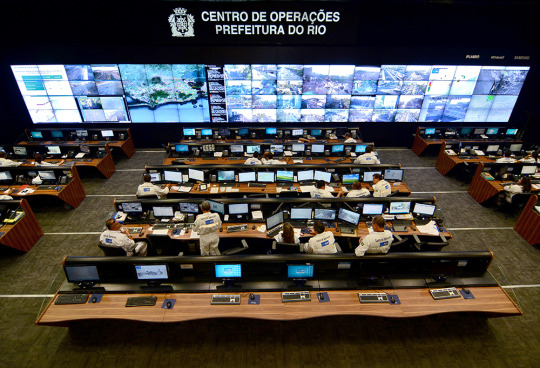
Rio’s Center of Operatios (Centro de Operações da Prefeitura do Rio). Retrieved from http://www.metropolismag.com/cities/big-data-big-questions-data-smart-cities/
4. Conclusion
To sum up, although Smart Cities seem to be a strong tendency for the future, they still must overcome many issues. The matter of whether technology should influence in policy-making – and more importantly, remain under the realm of already rich and powerful institutions such as governments – has to be addressed in the next years. In that sense, awareness of the population over the matter needs to increase, and is, therefore, one of the goals of this paper.
In the original online survey conducted by this Capstone group, the subjects were asked to briefly tell us about their background with social media. But we included an extra question. By the end of the form, we simply put “What is Big Data?” as an optional part. From the 779 responses, we obtained only 65 answers to this particular inquiry. And even between these few, many included variations of “I don’t know.” The outcome of the process described was clarifying, even though it was somewhat expected. Living immerse in a technological environment, we understand that the loss of privacy often seems natural and that concepts like Big Data are not really discussed. What surprised us, however, was the unwillingness of people to find more about it. Most of the participants didn’t even try to google the term, they just jumped the question. And that is worrying.
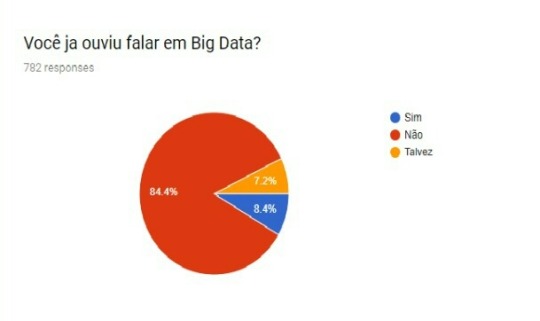
Translated from Portuguese: “ Have you ever heard of Big Data?” In red, “no”; in blue, “yes”; and in orange, “maybe”.
So, the best way to address the privacy issue is to invest in ways to inform the population about it. Once we are all aware of the complexity of Smart Cities and understand the possible consequences of it, we can demand our governments to be more transparent and to formulate concrete online privacy policies. Anyway, the future is uncertain, but it is possible to minimize its risks.
References (in order of appearance):
Hall, E. (2000). The Vision of a Smart City. Retrieved from: https://ntl.bts.gov/lib/14000/14800/14834/DE2001773961.pdf
Chen, W. & Wellman, B. (2004). The Global Digital Divide. IT&Society (1) 19. [1]
Duggan, M. & Brenner, J. (2013). The Demographics of Social Media Users – 2012. Pew Research Center. 2. [2]
Smith, A. (2013). Smartphone ownership – 2013 Update. Pew Research Center. 2. [3]
Chauhan, S.; et al (2016) Addressing Big Data challenges in smart cities: a systematic literature review. The Journal for Policy, Regulation and Strategy for Telecommunications, Information and Media. 2, 2-5.
Popescul, D. & Radu, L. (2016). Data Security in Smart Cities: Challenges and Solutions. Informatica Economica. 30.
Finch, K. & Tene, O. (2013). Fordham urban Law Journal. 41. 1602-1604.
Oum Hoon, T.; et al. (1999). Harwood Academic Publishers. 289.
Regan, P. (1995). Legislating Privacy: Technology, Social Values, and Public Policy. University of North Carolina Press. 74-75.
The United States Civil Rights Act (1965). Retrieved from https://www.ourdocuments.gov/doc.php?flash=false&doc=97&page=transcript [4]
Abbas (2007); Croucher & Cronn-Mills (2011); Gonzàlez, Verkuyten, Weesie, & Poppe (2008). [5]
Pollack, A. (February, 2015). Building a Face, and a Case, on DNA. New York Times: D1
Retrieved from https://www.law.cornell.edu/constitution/fourth_amendment [6]
Stewart, N. (2017). Those Needing Food Stamps Find City App Eases the Path. The New York Times. Published on July 25th, 2017.
Shaw, J. (2017). The Watchers. Harvard Magazine. 119 (3), 56.
Poole, S. (2017). Retrieved from https://www.theguardian.com/cities/2014/dec/17/truth-smart-city-destroy-democracy-urban-thinkers-buzzphrase [7].
1 note
·
View note
Text
E aí pessoal... preparades para ganhar o mundo??
Bóra agendar uma consultora de psicoterapia e adentrar este mundo mágico e sem volta que é o autoconhecimento?🐛🦋
Estou aguardando vocês 😉
Psicóloga Roberta Noble
CRP: 07/29529
Tel. 51.993993887
#psicologia #psicoterapia #psico #psique #psi #psicologarobertanoble #psicologa #terapia #terariaéterapia #motivação #autocuidado #autoestima #autoconhecimento #ganharomundo #atendimentoonline #amor #psicologiaadolescente #psicologiaadulto #psicologiainfantil #psicologiaclinica #"cuidado #carinho #quintafeira #outubro #2020
instagram
1 note
·
View note
Photo

Perder e Ganhar Jesus dizia a todos: “Se alguém quiser acompanhar-me, negue-se a si mesmo, tome diariamente a sua cruz e siga-me. Pois quem quiser salvar a sua vida, a perderá; mas quem perder a sua vida por minha causa, este a salvará. Pois que adianta ao homem ganhar o mundo inteiro, e perder-se ou destruir a si mesmo? Se alguém se envergonhar de mim e das minhas palavras, o Filho do homem se envergonhará dele, quando vier em sua glória e na glória do Pai e dos santos anjos. Garanto-lhes que alguns que aqui se acham de modo nenhum experimentarão a morte antes de verem o Reino de Deus”. Conheça o contexto: https://my.bible.com/pt/bible/129/LUK.9.NVI Sociedade Bíblica Internacional Nova Versão Internacional (NVI-PT) Biblia Sagrada, Nova Versão Internacional®, NVI® Copyright © 1993, 2000 by Biblica, Inc.® Used by permission. All rights reserved worldwide. #autodestruicao #autorenuncia #filhodohomem #ganharomundo #gloriadopai #jesus #morteeterna #palavradedeus #perderaalma #reinodedeus #salvaravida #santosanjos #sigajesus #tomeacruz #vidaeterna
1 note
·
View note
Photo

Hoje #acordei com uma #vontade #louca de #ganharomundo 🖤🦇 By @thaisgusmaoaholic #bomdia #brazilianboys #instagay #batman #inlove #curitiba #gaysexy #velhochico #guerreiro #força #superheroi #quartafeira #boy #ezatamentchy #beargay #model #vaimalandra #quetirofoiesse #sp #meninosonline (em Curitiba, Brazil)
#força#ganharomundo#vaimalandra#quetirofoiesse#bomdia#instagay#beargay#sp#superheroi#boy#velhochico#gaysexy#ezatamentchy#model#meninosonline#acordei#inlove#guerreiro#vontade#louca#batman#quartafeira#curitiba#brazilianboys
0 notes
Photo

CURSO PRESENCIAL REALIZADO EM 19/06/2019 Mais um profissional da Área da Pintura Hidrográfica formado. A Região da Penha ganha seu primeiro profissional em WTP. Entre em contato conosco e lhe indicaremos um profissional de Qualidade, formado pela SpaceArts / PersonaMix , para realizar serviços de pintura hidrográfica em suas peças e realizar seu projeto de customização. #cursopinturahidrografica #cursodepinturahidrografica #curso #prezeremtrabalhar #proprionegocio #grana #money #rendaextra #rendaextraemcasa #planob #sejaempresario #sejaseupatrao #lucro #personamix #wtpbrazil #customizacaoautomotiva #customizador #profissionalizar #artegaragem #artpaint #art #artenova #artenaagua #negociolucrativo #novonegocio #independenciafinanceira #facaseutempo #ganharomundo (em Jacarepaguá, Rio de Janeiro) https://www.instagram.com/p/By-IehUAQOe/?igshid=f44ajvjtuxz5
#cursopinturahidrografica#cursodepinturahidrografica#curso#prezeremtrabalhar#proprionegocio#grana#money#rendaextra#rendaextraemcasa#planob#sejaempresario#sejaseupatrao#lucro#personamix#wtpbrazil#customizacaoautomotiva#customizador#profissionalizar#artegaragem#artpaint#art#artenova#artenaagua#negociolucrativo#novonegocio#independenciafinanceira#facaseutempo#ganharomundo
0 notes
Photo

E acordei com essa vontade de sempre. Bom dia. ✈ #viajar #GanharOMundo
1 note
·
View note
Photo

No coments! #sonho #medos #ganharomundo #sejoga #musica #sedescubra #sigaemfrente (em Medianeira)
3 notes
·
View notes
Text
The Instagram Project
The Instagram Project was part of the final assignment at the Pre-College Intensive Summer English Program, a course offered by the English as a Second Language (ESL) department of The New School. During the seven weeks of classes, we students were oriented to take pictures of different objects across New York City. These photographs were presented through an Instagram account made especially for this purpose and were later curated to figure in a class showcase.
Each of us has chosen a framework to work with, although most pictures were taken without a specific intention. I now display the final result of this process.

Abstraction in Concrete
The idea behind my framework “Abstraction in Concrete” is to picture the concepts of concreteness and abstraction in harmony, not contrasting each other. In their overlap of shapes and colors, the following images try to capture physical aspects of New York City, but through a different point of view. From the use of unusual camera angles to the creation of metaphors, the focus is on elements that challenge first impressions and invite the viewer to immerse in this melting pot of sensations that is life in the Big Apple.
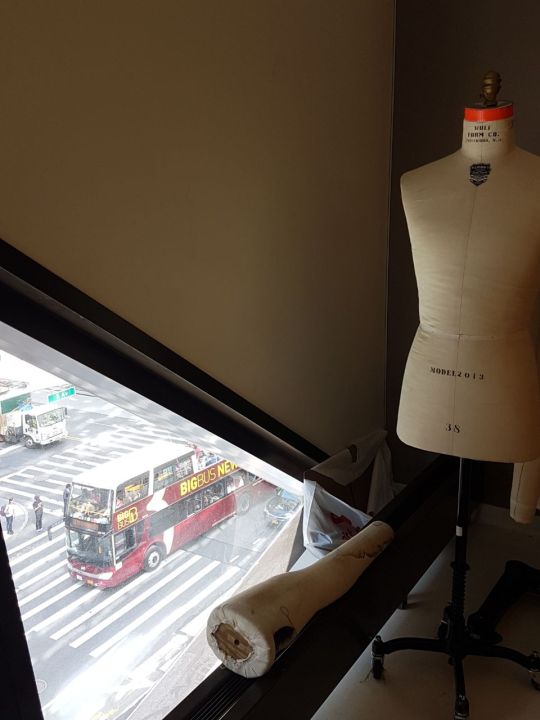
Flying art
Taken at MoMA, on July 8th.
The Bell-47D1 Helicopter, exposed at MoMA, seems to be aimed to break our expectations. The apparent inutility of such location for the placement of a aircraft causes discomfort and catches the eye, plus invites the audience to deeper reflect over the meaning of art itself. With this photo, I hoped to capture the essence of the piece and go against the idea that art is something above us (despite the fact that, in this particular case, it is). By the flow of people and the contrasts in light and shape, I show how art can integrate the regular environment while transforming it.

Our colorful Window
Taken at McGee’s Pub, on July 13th.
In this picture, I used an actual frame (the window itself) to reframe the way we see the urban environment. What stroke me in it was the overlapping of the green leaves and the gray buildings. I believe it is aesthetic in its contrast of shapes and colors. Plus, it gives the viewer the sense of movement that is so characteristic of big cities. At the same time, the shamrock transpires creativity and optimism, once it is the Irish symbol of good fortune. For me, we can easily compare the window to our own mindset, as it is possible to curate our view of reality, by bringing some color to it.

The inevitable EXIT
Taken after the “Groundhog Day” play, on July 19th.
The following photograph is not just about the exit sign itself, but also about the manner in which it interacts to its surrounding. When I first glimpsed at this picture, I instantaneously thought of Charlie Chaplin’s movie “Modern Times”. More specifically, it reminded me a lot of its opening scene, where the workers leaving the subway were compared to cattle. At the time I took the photo, though, it was the audience leaving the play the one to be objectified. Seeing this kind of homogeneous crowd, the importance of being your true self and not fading into social patterns became more evident to me. After all, the inevitable exit of life is closer than we think.
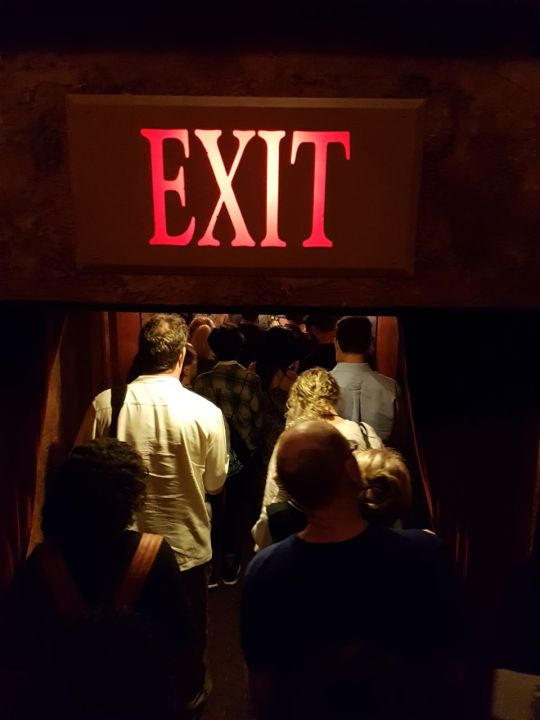
The Climb
Taken at DUMBO, on June 26th.
What we see in the picture are workers cleaning the side of a building. We see vertical lines and glass too. But more than that, we see the men’s effort to cover the entire wall, in a slow climb to the top. In that sense, we can bring this whole situation to our daily lives, as each of us tries to reach our goals and dreams. In our own pace, we face challenges and overcome obstacles, this way improving ourselves.
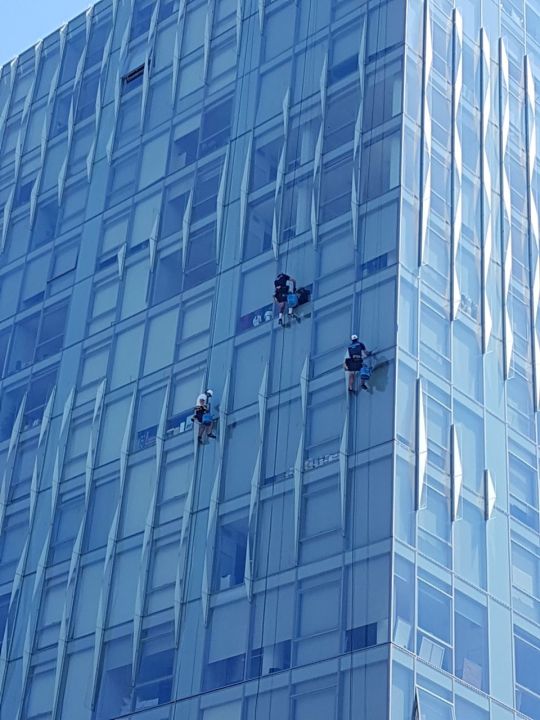
See the full project at https://www.instagram.com/gloria.sousasummeresl/
1 note
·
View note